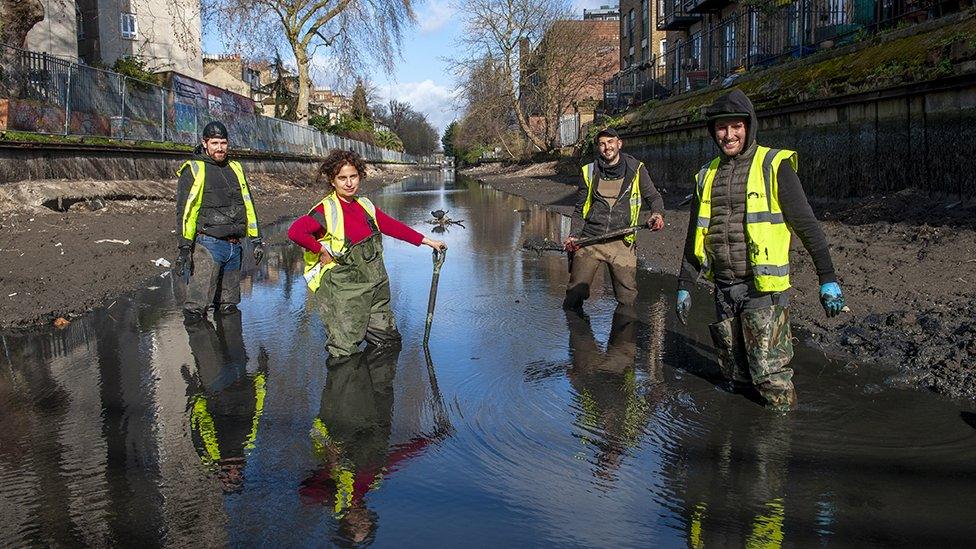Hidden treasure: Hertford Union Canal gives up its secrets
- Published

In January, the Hertford Union Canal in East London was drained for essential repairs for the first time in 20 years, and is due to be refilled in April. The Canal and River Trust put out a call for volunteers to clear out the rubbish from the 191-year-old canal. Anna Borzello went along with a group of friends who normally search the Thames foreshore for archaeological artefacts (a hobby known as mudlarking) to find out what had lain beneath the waters.
As I stepped off the ladder and onto the exposed bed of the Hertford Union canal, heading towards what I hoped was a Victorian bottle, I sunk straight in above my knees, and spent the next five minutes trying to dig myself out with a shovel.

A modified doll's head with a screw through its nose was found on the canal bed by Nicola White

Canal mud is treacherous, deceptively solid-looking on the surface but giving way to thick sludge beneath. Shallow water pooled in the centre of the three-quarters of a mile (1.2km) long trench, but sediment swirled with every step, making it hard to see anything.
The ground was covered with rubbish. Tyres were everywhere; twists of metal poked from the mud; a pull on a handlebar revealed a bicycle. The side of a park bench and what looked like a lamppost lay half-submerged.


Much of the rubbish had been dumped by fly-tippers.
At the lock linking the Regents and Hertford Union Canal, we waded through water full of mobile phones, chunks of obsolete technology and car numberplates, including one that had been mysteriously chopped up into tiny bits and wrapped tightly in a plastic bag.

Clean-up volunteers with the Canal and River Trust removed old tyres from the exposed canal bed

This wasn't the only apparent evidence of crime. There were safes, empty apart from mud. Volunteers also found a BB gun and a sword, age and provenance unknown.
A friend who lives on a barge told me that many things were lost over the side - vandals love to chuck in plant pots from the tops of boats, while cutlery is sometimes thrown out with the dishwater.
She suggested that many tyres lying on the mud originally hung from the sides of boats to prevent scrapes when they pulled in for mooring.
There were surprising finds. Mike Walker kicked against a round object in shallow water and discovered a WW2 helmet.

Mike Walker with his star canal find: a World War Two helmet

Simon Bourne found a birdcage lying in the shallow water


A better class of litter: a late 19th Century stoneware R White's ginger beer container was found in the mud by Nicola White


Monika Buttling-Smith with the figures of three Hindu gods that were found in the canal

Some objects, like traffic cones, must have been lobbed in by bored teenagers. Others items were chucked into the water in anger.
As we battled through mud, a woman shouted down to ask if we had seen her friend's bicycle: he had been in a traffic dispute with the driver of a car who had thrown his bike off the bridge and into the canal.
I overheard two people on the towpath musing whether the motorbike lying beneath them belonged to "Andrew", pushed in from the adjacent car park.

Found scattered under a bridge, a tiny animal collection: four horses, three polar bears and a gorilla
I don't know why there there was a collection of tiny ceramic polar bears, horses and a gorilla beneath a bridge, but I imagine an angry child hurling in his sibling's collection.
Litter was everywhere, beer cans and plastic wrappers dropped by people who couldn't be bothered to find a bin.
All the rubbish was piled on the towpath by CRT volunteers. The rubbish is treated as toxic and will be taken away by a barge for disposal when the canal is refilled in April.


The Hertford Union Canal was never a commercial success, but it runs alongside the busy Victoria Park and has seen working, wartime and leisure activity for close to 200 years, as well as industry along its banks.
One volunteer discovered a horseshoe, possibly dating to the era of horse-drawn canal barges, while Nicola White came across a perfect 19th Century stoneware ginger beer, as well as a small aqua ink bottle, from a time before biros and felt-tip pens.
Perhaps some of the older objects have been removed by dredging.

A sword of unknown age and provenance was found in the mud
It's likely small items, like coins and rings, have sunk into the deep mud. Other treasures may have been pulled out by people fishing with magnets, an increasingly popular hobby.
Heritage items, like the helmet and sword, will be kept by the CRT and returned to the finder if they are found not relevant to the canal's history.
The jumbled objects beneath the water may not be your average treasure, but they are clues to the everyday lives and emotions of the people who live above the surface.
You can see Anna Borzello's mudlarking finds on Instagram @foreshoreseashore, external